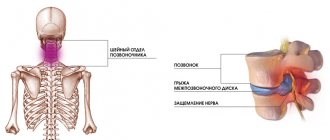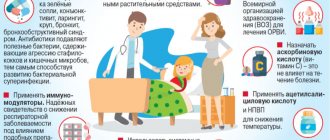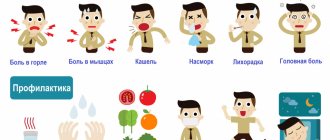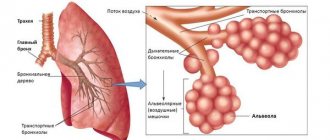A little more terminology
ARI is a very broad concept. We are familiar with it like a cold. Main symptoms: sore throat, runny or stuffy nose, hoarseness, chills, malaise, slight fever. ARI combines diseases of various natures (viral, bacterial, fungal, mixed). Manifestations of acute respiratory infections have a fairly specific location (focus of infection) with a predominance of local lesions of the mucous membranes (nose, throat, vocal cords).
ARVI is a narrower concept that assumes a viral cause of the disease. The symptoms are close to those of acute respiratory infections, but have more pronounced signs of intoxication.
Neither acute respiratory infections nor acute respiratory viral infections are diagnoses! These are only general concepts that have left the medical vocabulary. While "flu", "ARI" and "ILI" are medical terms.
ARI is an acute respiratory infection.
ILI is an influenza-like illness.
Where can I get tested for influenza?
You can get tested for the influenza virus and other pathogens of respiratory infections at the Center for Molecular Diagnostics (CMD). It is advisable to get tested for the detection of influenza and ARVI pathogens if you suspect a viral infection on the first or second day of the disease, when the pathogen is contained in the body in maximum quantities.
Diagnosis of influenza and acute respiratory viral infections in CMD:
- Influenza virus (Myxovirus influenzae) A and B, qualitative determination of RNA, PCR
- Influenza virus (Myxovirus influenzae) A and B/ Parainfluenza virus (Parainfluenzae virus) types 1,2,3,4, qualitative determination of RNA
- Influenza virus (Myxovirus influenzae) A, A/H1N1/CA/2009, B, qualitative determination of RNA, PCR
- Diagnosis of ARVI. Causative agents of respiratory viral infections (RNA Respiratory Syncytial virus, RNA Metapneumovirus, RNA Coronavirus, RNA Rhinovirus, DNA Adenovirus B, C, E, DNA Bocavirus, RNA Parainfluenza virus 1, 2, 3, 4), qualitative determination, PCR
Main signs and symptoms of acute respiratory infections, acute respiratory viral infections and influenza
(in the first 24-48 hours from the onset of the disease)
| Sign* | acute respiratory infections | ARVI | Flu |
| Cause (etiology) | Viruses, bacteria, etc. | Various viruses | Only influenza viruses |
| Epidemiological situation | – | + | ++ (declaration of influenza epidemic) |
| Contact with the patient | – | + | +++ |
| Acute onset (with the onset of fever), against the background of complete health | – | + | +++ |
| Previous provoking factor (hypothermia, temperature contrast, etc.) | +++ | + | – |
| Difficulty in nasal breathing | ++ | +++ | +/– |
| Runny nose | ++ | +++ | +/– |
| Pain or discomfort in the throat | +++ | ++ | +/– |
| Cough | ++ | +++ | ++ |
| Severe weakness, fatigue, lethargy | +/– | + | +++ |
| Sleep disturbance | +/– | +/– | ++ |
| Increased excitability | – | + | +++ |
| Sweating | ++ | + | ++ |
| Decreased appetite | + | ++ | +++ |
| Nausea, vomiting | – | + | ++ |
| Temperature rise to 38.5°C | +++ | ++ | – |
| Temperature rise above 38.5°C | + | ++ | +++ high fever, persistent from the first hours of the disease |
| Body aches, chills | + | ++ | +++ |
| Muscle pain | – | + | +++ |
| Muscle tremors | + | ++ | +++ |
| Headache, dizziness | + | + | +++ |
| Pain in the eye muscles when moving them or pressing on them | – | – | +++ |
| Photophobia, lacrimation | – | – | +++ |
| Nosebleeds, pronounced blood vessels in the eyeball, hemorrhagic rashes | – | – | ++ |
*Characteristics of the trait according to the probability of presence/degree of expression:
| – | no or unlikely/pronounced |
| + | occurs / is expressed slightly (weakly) |
| ++ | highly probable / moderately expressed |
| +++ | clearly marked/pronounced significantly (brightly) |
This table only generally characterizes the manifestations; it is necessary to remember about the individual course and atypical forms of the disease.
You need to seek help from a doctor!
How diagnostic tests work
Molecular genetic methods, in particular polymerase chain reaction (PCR), are capable of detecting the genome of the pathogen in a smear from the nasopharynx of a sick person.
PCR is a fast, direct diagnostic method that can detect specific regions of the genome of microbes, that is, distinguishing them from each other. The PCR method is essentially a rapid test for influenza and other respiratory infections.
The basis of the method is repeated selective copying (amplification) of a certain section of DNA/RNA in order to obtain such an amount of genetic material that will be sufficient for visual detection. In this case, only a given portion of the genome is copied many times. Since the genome is a unique part of each organism, PCR allows you to accurately determine which virus caused the disease. Consequently, the doctor, based on the results of this analysis, will be able to prescribe treatment that will be effective against a specific virus.
Signs of depression and excitation of the central nervous system
| Sign* | CNS depression | Excitation of the central nervous system |
| General activity | reduced | the child is extremely irritable motor restlessness convulsions are possible |
| Sucking | sluggish | may not change or the baby refuses the breast/bottle |
| Scream | lethargic | piercing frequent |
| Dream | frequent difficult to wake up | shallow rare it's hard to fall asleep |
Catarrhal manifestations of the upper respiratory tract (runny nose, difficulty nasal breathing, sneezing, cough) may be absent.
How to distinguish it from the flu
Seasonal influenza is also similar in symptoms to coronavirus. However, there are still some differences. First, influenza is characterized by a sharp deterioration in the patient’s condition, while with COVID-19, symptoms appear gradually and their severity increases.
In the vast majority of those infected, the flu causes a rise in body temperature to 38–39 degrees. With coronavirus, the indicator depends on the form of the disease.
- With a mild degree of damage to the body, a slight deviation from the norm is recorded - about +37...+37.5 degrees.
- In severe cases, the temperature can rise to 40 and above.
For acute respiratory viral infections, you can lower the temperature with the help of tablets, suspensions and other medications containing paracetamol or ibuprofen. If a patient has coronavirus, the usual antipyretic drugs often bring little or no relief. The temperature either does not drop completely, or drops for a short period of time, and then again reaches critical values.
For both influenza and COVID-19, a characteristic symptom is a cough. However, its type varies. COVID-19 is always accompanied by a dry cough, and the infected person feels shortness of breath and difficulty breathing. Influenza is characterized equally by a wet cough with copious sputum production and a dry one.
Another significant difference between coronavirus and seasonal types of influenza is the possibility of the disease occurring in the complete absence of symptoms. The infected person does not experience any discomfort and does not even notice that he is sick. But it remains very dangerous for others, as it is capable of infecting a large number of people.
About the mode
Rest, bed rest and drinking plenty of fluids are recommended.
If the child is breastfed, then more frequent breastfeeding is advisable. You can offer water, as the need for liquid increases as the temperature rises.
If the baby is bottle-fed, then it is necessary to offer the baby regular drinks (water or baby teas) more often. Adding a fermented milk mixture to your diet, for example, Nutrilak Premium Fermented Milk, will facilitate the digestion process and maintain the balance of the microbiota, promoting a speedy recovery.
Children over 1.5-2 years old often experience a decrease in appetite, so children's drinks, for example, Nutrilak Premium 3 or 4, will be indispensable. They will support the baby's immune system and quickly restore his strength.
How is ARVI transmitted?
They are transmitted primarily by airborne droplets, that is, through the air along with the sputum of a sick person when he sneezes or coughs.
Flu epidemic
An influenza epidemic occurs in our country every year. We are learning to resist the disease from the experience of last season. Lyudmila Tsybalova, Deputy Director for Research at the Influenza Research Institute of the Russian Academy of Medical Sciences, tells the story.
Viruses cause inflammation of the mucous membrane of the nasal cavity, nasopharynx, throat, trachea and bronchi.
Features of treatment and prevention.
To prevent viral infections, the pediatrician advises staying less in crowded places. If this cannot be avoided, try to always use special protective masks. During periods of epidemics, limit your child’s visits to sports clubs, shops and any other public places. At the slightest sign of illness, it is better not to send your child to school or kindergarten.
It is necessary to pay special attention in advance to strengthening the child’s immunity. Infants and very young children need to be provided with proper feeding, nutrition and care. Older children are prescribed vitamin therapy.
The basis of treatment for all acute respiratory viral infections is the use of symptomatic therapy. It includes proper drinking regimen, taking antipyretic and antihistamine medications, vitamin C. You must drink at least 2 liters of fluid per day. This helps the body cope with fluid loss due to heavy sweating at high temperatures, and also helps thin mucus and clear it when coughing. During illness, the body loses not only water, but also useful substances, so for drinking you should use drinks containing vitamins and microelements. It is best to drink mineral water, juices, and berry fruit drinks.
In acute respiratory viral infections, antipyretic drugs are used to reduce fever, as well as to reduce inflammation and as a pain reliever. Paracetamol is most suitable for children. It is well tolerated, practically does not irritate the gastric mucosa, does not cause severe allergic reactions and Reye's syndrome in children. Paracetamol is even used to treat children under 3 months of age.
Very often, acute respiratory viral infections are accompanied by nasal congestion, copious mucus discharge from the nasal passages, etc. In such cases, it is usually recommended to use antihistamines. They relieve swelling well and help children tolerate the disease more easily.
How to treat colds in children , because they don’t like taking medicine so much? In this case, a complex drug is best suited for their treatment. But it is a mistake to believe that the more components a drug contains, the more effective it will be. The composition of the classic complex medicine is paracetamol, an antihistamine and vitamin C. Among such drugs is (Natur Produkt), which has a special “children’s formula”. It contains the same components as in drugs for adults, but in a lower dosage. Its advantage over other drugs is that it has a water-soluble form, in the form of effervescent tablets with a pleasant taste. It does not damage the gastric mucosa, and also ensures a faster supply of active ingredients, and the effect occurs immediately after administration. In addition, it is much easier to persuade a child to drink tasty medicine.
Differences between diseases by duration
Symptoms of ARVI appear 1–4 days after contact with the pathogen. The usual incubation period for colds is 2–3 days, after which patients begin to feel the first symptoms. Coronavirus takes longer to manifest – about 5–14 days. During the incubation period, the infected person does not experience discomfort. If he can approximately determine when contact with the carrier occurred, then the length of the incubation period will determine the type of disease.
Coronavirus can also be distinguished by the duration of the disease. For colds, relief occurs within 3–7 days. Flu goes away without complications within 10–14 days. When infected with coronavirus, characteristic symptoms can be observed within 2-4 weeks. The duration of the disease directly depends on the form of the disease, the timeliness and correctness of the prescribed treatment, as well as on the general condition of the body and the immune system of the infected person.
Another difference between a standard ARVI and a coronavirus is the likelihood and timing of complications, primarily pneumonia. The coronavirus progresses quickly, so severe lung damage can be observed as early as 9–15 days after infection. With ARVI, pneumonia also appears, but with seasonal influenza this complication develops somewhat later. It is usually provoked by the addition of a bacterial infection. In addition, the degree of damage to the lungs during ARVI is much less, and COVID-19 affects almost completely alveolar tissue, which complicates treatment and increases the recovery period.
Should you go to the doctor with cold symptoms?
Only a doctor can recognize a virus and distinguish it from a bacterial infection. In addition, the doctor has information on the flu viruses that are widespread this year, which, by the way, can masquerade as a common cold. And one more plus - only a doctor can provide a sick leave certificate, which will allow you to recover at home, and not endure the disease on your feet.
As for treatment, the therapist and pediatrician prescribe medications to eliminate the pathogen and symptoms (antipyretics, sprays for the throat, nose, gargling, inhalations), selecting medications that are appropriate for the patient’s age and weight. Another task of the doctor is to prevent complications. By self-medicating, you are simply wasting time. Alas, jokes with health too often end in tragedy!








